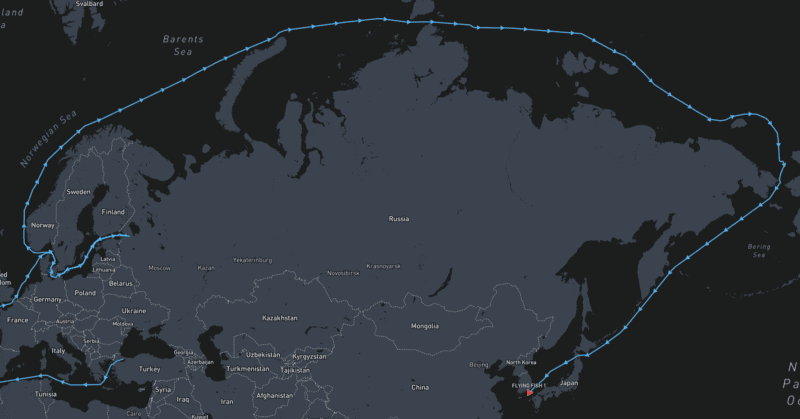U.S. Customs Revenue Tops $100 Billion for First Time Amid Tariff Surge
US revenue from customs duties this fiscal year surpassed $100 billion for the first time, reflecting higher tariffs imposed by the Trump administration.

(gCaptain) – The first Arctic transit of a large container ship has gone off without a hitch. The 294 meter-long Panamax vessel Flying Fish 1, traveled from St. Petersburg in the Baltic Sea to China in just over three weeks, shaving around two weeks off a standard voyage via the Suez Canal.
It is set to arrive at its destination in Shanghai early on September 26. The vessel is operated by EZ Safetrans Logistics out of Hong Kong.
The proposition of regular summer season box shipping across Russia’s Northern Sea Route seemed impossible to most just a decade ago. This year the Arctic Ocean will see close to 20 transit voyages, all connecting Russian and Chinese ports via the Arctic shortcut.
Capable of carrying 4,890 twenty-foot equivalent containers it sets a new standard for Arctic container shipping. Prior to this summer only smaller box carriers holding around 1,500-2,000 gave the Arctic shortcut a try. Over the past three months several larger feeder vessels have established a seasonal liner service between ports and China and Arkhangelsk and St. Petersburg.
Flying Fish 1 departed from St. Petersburg on September 3 and entered the Northern Sea Route at the top of Novaya Zemlya a week later. Shortly thereafter it crossed paths with another Chinese container ship, the first encounter of two large box carriers high in the Arctic. The nighttime rendezvous occurred just 850 nautical miles from the North Pole, with no sea ice in sight.

The vessel was able to maintain a speed of 16 knots across the entire length of the route, indicative of how Arctic ice conditions have dramatically changed over just the last two decades. Flying Fish 1 continued through the Laptev and East Siberian Sea, avoiding some late-summer ice near Wrangel Island.
It exited from the route and passed through the Bering Strait near Alaska on September 17, without requiring any icebreaker assistance, just six days after entering the Russian Arctic.
Once complete, its journey from the Baltic Sea to Shanghai will measure approximately 8,000 nautical miles, around 4,000 nautical miles shorter than the traditional route via the Suez Canal. The current detour for most vessels around South Africa due to instability in the Red Sea adds another 4,000 miles to the standard route to Asia.
For now shipping services between Europe and Asia via the North remain limited to a 3-4 months summer window, but as sea ice retreats earlier in summer and returns later in winter more operators will surely look to the Arctic for new opportunities.

Sign up for gCaptain’s newsletter and never miss an update

Subscribe to gCaptain Daily and stay informed with the latest global maritime and offshore news


Stay informed with the latest maritime and offshore news, delivered daily straight to your inbox
Essential news coupled with the finest maritime content sourced from across the globe.
Sign Up